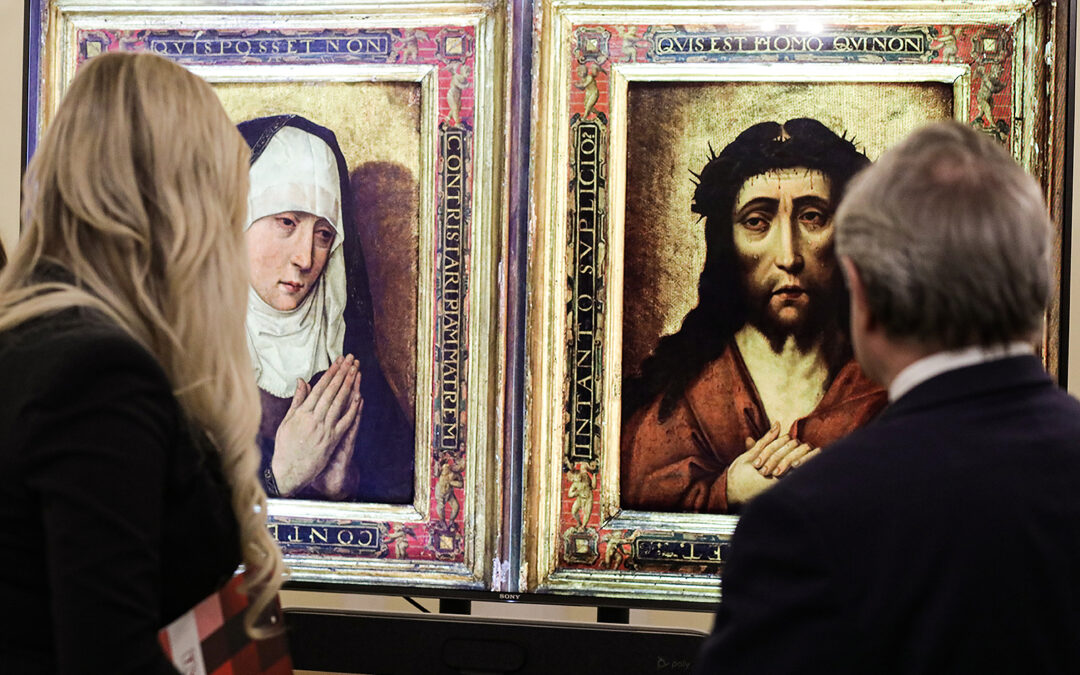Two historical paintings stolen from Poland during the Nazi-German occupation of World War Two, and which subsequently disappeared for decades, have been returned after being discovered at a museum in Spain.
They represent the latest in a series of artworks restituted to Poland amid an ongoing campaign by the government to locate the hundreds of thousands of cultural items that still remain missing after being looted during the war.
🔴Odnaleziony w Hiszpanii dyptyk z warsztatu Dierica Boutsa wraca do Polski‼️ Przekazanie stronie polskiej dwóch obrazów z warsztatu Dierica Boutsa, stanowiących polskie straty wojenne, odbyło się dziś w Museo Provincial de Pontevedra
Więcej: https://t.co/ANWOYTmONf pic.twitter.com/B73eThP1YN
— Ministerstwo Kultury i Dziedzictwa Narodowego (@kultura_gov_pl) January 25, 2023
The artworks originate from the workshop of renowned Flemish master Dieric Bouts, who was active between the 1440s until his death in 1475. The paintings themselves were most likely produced in the second half of the 15th century or first quarter of the 16th century, says Poland’s culture ministry.
The pair of religious images, titled Mater Dolorosa and Ecce Homo and depict the Virgin Mary and Christ, together form a diptych – a singular piece of art formed by hinged wooden panels.
They became part of the Polish Czartoryski collection at Gołuchów Castle, near Poznań, in 1883. Following the outbreak of the war in 1939, the diptych, along with other pieces from the collection, was moved to Warsaw. It is thought to have remained in the National Museum in Warsaw until the outbreak of the 1944 Warsaw Uprising.
The exact date on which the diptych was removed from Poland and where it was taken to remain unknown. But the paintings were included on a list compiled by the German authority overseeing the looting of art in occupied Poland, notes the culture ministry.
In 2019, they were identified by an employee of the ministry in the collection of the Provincial Museum of Pontevedra in Spain. Two years later, culture minister Piotr Gliński submitted a formal request for their restitution. That was granted in December 2022 by the Spanish culture ministry.
The director of the Spanish museum, Juan Manuel Rey, said that the illegal origin of the paintings was “completely unknown” to his institution, which was now glad that “justice” was being done with their return, reports broadcaster RTVE.
The museum received the paintings from the collection of one of its major benefactors, businessman José Fernández López, who reportedly acquired them at a gallery in Madrid or Barcelona in the 1970s.
A restitución ao Estado polaco dos cadros que conforman o díptico Mater Dolorosa e o Ecce Homo xa é unha realidade. Un fito histórico para toda Europa 👏👏 pic.twitter.com/RJQ8BcU5qq
— Deputación Pontevedra (@depo_es) January 25, 2023
Announcing the paintings’ return to Poland, Gliński praised the professionalism and cooperation of the Spanish side in facilitating the process.
The minister noted that Poland lost more than half a million works of art during the war, with the majority remaining missing. He revealed that there are currently around 130 restitution processes underway in more than a dozen countries around the world.
“We recover our losses often through contacts with institutions or individuals around the world who are involved in or interested in the search for artworks,” said Gliński. “These include museum professionals, art historians, but also agencies – Polish and foreign – and our diplomats. This system is very extensive.”
The paintings will return to their former home at Gołuchów Castle, which is now a branch of the National Museum in Poznań.
Main image credit: Danuta Matloch/MKIDN (under CC BY-NC-ND 3.0 PL)

Anna Hackett is an assistant editor at Notes from Poland. She is a recent graduate of European Studies from Trinity College Dublin and has had previous journalistic experience with the Irish Independent News & Media group.




















